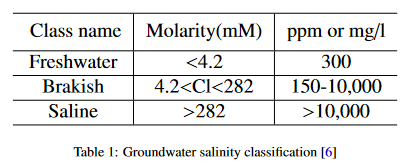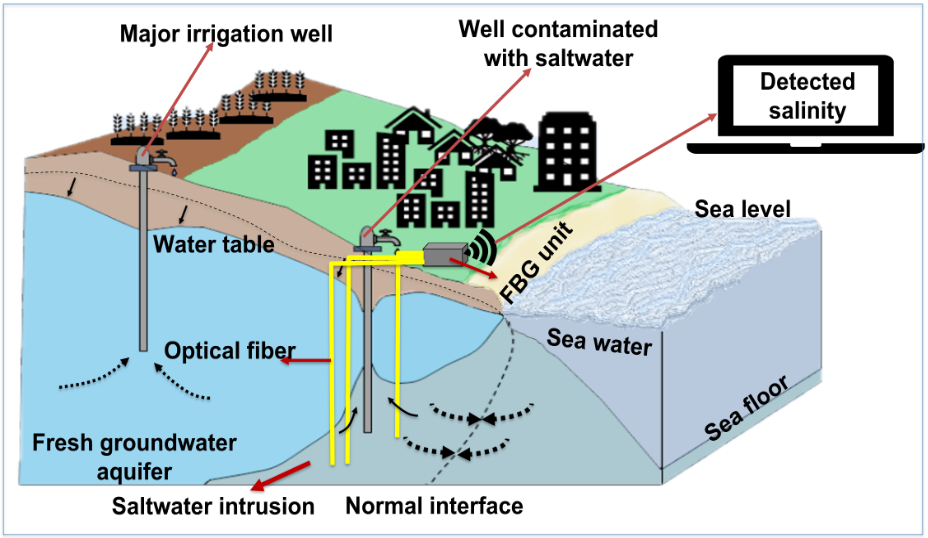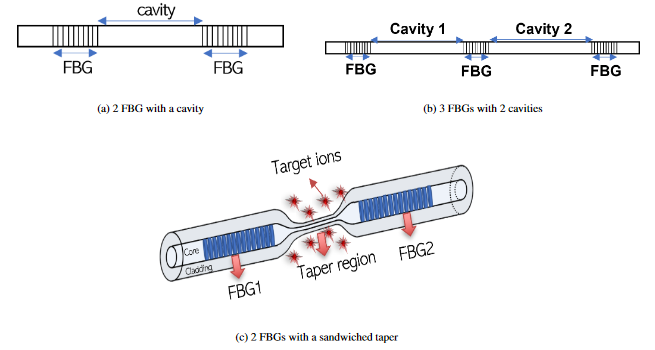Dhyana Challeparambil Bharathan
Groundwater is one of the most important natural resource and it supplies almost half of the available drinking water in the world [1]. It also plays a significant role in the food production and agricultural industry, contributing to more than 40% of the global consumptive use in agricultural irrigation [2]. With a withdrawal rate of 980 km3/yr, groundwater is known to be the most extracted raw material in the world [3]. Hence, groundwater have a consequential part in sustaining human life. Degradation of groundwater aquifers have become a major issue over the years with population growth and industrial development which lead to over exploitation of the resource impacting both water quantity and quality. Figure 1 shows an overall classification of groundwater quality problems. Out of these, aquifer salinization is one of the prominent causes which in turn can arise due to human activities, such as land alterations, road salts (for de-icing) and irrigation return flows; as well as from natural causes, arising from weathering, atmospheric deposition and saltwater intrusion [4, 5]. Measurement of groundwater salinity is based on the concentration of the total dissolved salts (TDS)- i.e. milligrams dissolved solids per litre of water, but the use of proxies such as the Chloride Content (mg/l) or the Electrical Conductivity (EC, in μS/cm) is widespread as well. On the basis of chloride content, groundwater quality can be classified into different classes as given in table 1.

The conventional methods for salinity measurement involve chemical analysis and geophysical prospecting [8, 9]. These methods can be mainly realized based on the titration [10], specific gravity [11], conductivity temperature depth (CTD) [12] and optical method [13]. The titration and specific gravity method can achieve high-precision measurement, but the process is complicated, and it is difficult to achieve in-situ, real-time monitoring. The CTD method is a commonly-used commercial and traditional salinity monitoring method, which determines the salinity by measuring the conductivity of the liquid [14, 15]. However, the electronic sensors, are susceptible to electromagnetic interference and not so friendly for the applications far away from land. As these instruments determine water salinity by measuring the conductivity of the soil solution. Some non-conductive components that have effects on the density of the solution can lead to errors in the measurement results [16]. Although these designs are excellent, most designs must install specific hardware or software to detect the salinity, resulting in unacceptable costs [17].
Therefore, in this project we propose to use optical fiber sensors as an elegant alternate way to detect and monitor the salinization of groundwater aquifers. Compared to the existing methods optical fiber sensors have the advantages by being immune to electromagnetic interferences, having small size, being capable of long distance data transfer and multiplexing capabilities, potential low cost in fabrication and development, safe and non-polluting to environment [18].
Recent research at Wetsus showed the potential of Fiber Bragg Grating (FBG) based fiber optics based sensors [19]. Fiber optical cables can be installed vertically into the subsurface with a direct push technique [20] and provide continuous high-resolutions real-time information about the aquifer. From the investigation of previous project, different type of optical fiber based sensors for groundwater flow monitoring were studied [21], which included Distributed Temperature Sensing (DTS) and one based on Fiber Bragg Gratings (FBGs). DTS allows for the measurement of temperature along the length of the fiber optical cable, and when combined with a heating cable, DTS also allows for the measurement of flow velocities. This was demonstrated at a well field of a drinking water company.

Figure 1: Basic principle of Fiber Bragg Gratings (FBG)
FBGs are basically individual sensors developed by inscribing refractive index modulations onto the core of a fiber optical cable which is capable of reflecting a particular wavelength [22]. This reflection is affected by bending, stretching or compression of the cable. FBG is an established technique in the aerospace industry [23], environmental and biochemical applications [24], structure health monitoring [25], and many other fields but was until recently not used for groundwater sensing. FBGs can sense anything that creates an alteration in the factors determining the reflected Bragg wavelength from temperature, strain, refractive index, pressure, vibration, humidity and many more [26] (figure 3). FBGs are combact, easy to fabricate and have exceptional multiplexing capailities as well as is capable of withstanding harsh environments [27], which make the technology suitable for sensing in complicated aquifer systems. However, the capabilities of FBG sensors for geohydrological and water quality measurements can be further expanded. Therefore novel approaches are needed to develop distributed chemical sensing. Preferably, approaches that can be integrated with distributed sensing of hydrogeological parameters [19]. The aim of this project is to develop the sensor capabilities needed to evaluate or apply targeted measures to detect and monitor groundwater degradation. In the beginning stage of the project we focus on the capability to trace the transport of salt or pollutants towards drinking water wells in coastal aquifers as seen in figure 2:

figure 2: Remote sensing unit of FBG sensors installed for monitoring saltwater intrusion in the coastal aquifers inorder to identify quality of drinking water
The sensing is based on evanescent sensing of the refractive index between two equal FBGs. The two FBGs show a modulated reflection spectrum (a broad spectrum with fine fringes) and the intrusion of salt moves the fringe pattern under the broad envelope. The sensitivity to the salt water is created by thinning the fiber in a small section between the two FBGs, creating a defined length over which the light senses the surrounding water. Salt intrusion will change the refractive index of the water and therefore the fringes will move. The sensitivity can be further enhanced by using three FBGs in line. The three FBGs produce a slow beat on the modulation of the two FBGs due to optical vernier effect [28]. The beat moves (faster than the fringes) as a function of the refractive index changes. Figure 5 shows a schematic representation of approach. To avoid interference of different effects and confusion, the FBGs have to be suspended free from strain which can be achieved by careful packaging. Apart from avoiding the interference, it can also be monitored and taken into account by including strain and temperature sensing FBGs in the same package.

figure 3: Schematic representations of FBG configurations in approach 1
References
[1] World Water Assessment Programme (United Nations) and UN-Water. Water in a changing world. 2009.
[2] Stefan Siebert, Jacob Burke, Jean-Marc Faures, Karen Frenken, Jippe Hoogeveen, Petra Döll, and Felix Theodor Portmann. Groundwater use for irrigation–a global inventory. Hydrology and earth system sciences, 14(10):1863–1880, 2010.
[3] Jean Margat and Jac Van der Gun. Groundwater around the world: a geographic synopsis. Crc Press, 2013.
[4] Martina Flörke, Ilona Bärlund, Michelle TH van Vliet, Alexander F Bouwman, and Yoshi-hide Wada. Analysing trade-offs between sdgs related to water quality using salinity as a marker. Current opinion in environmental sustainability, 36:96–104, 2019.
[5] Frank Van Weert, Jac Van der Gun, and Josef Reckman. Global overview of saline groundwater occurrence and genesis. International Groundwater Resources Assessment Centre, 2009.
[6] VEA Post, H Van der Plicht, and HAJ Meijer. The origin of brackish and saline groundwater in the coastal area of the netherlands. Netherlands Journal of Geosciences, 82(2):133–147, 2003.
[7] SSD Foster and PJ Chilton. Groundwater: the processes and global significance of aquifer degradation. Philosophical Transactions of the Royal Society of London. Series B: Biological Sciences, 358(1440):1957–1972, 2003.
[8] N Subba Rao. Factors controlling the salinity in groundwater in parts of guntur district, andhra pradesh, india. Environmental monitoring and assessment, 138(1):327–341, 2008.
[9] RD Barker. Investigation of groundwater salinity by geophysical methods. In Geotechnical an Environmental Geophysics: Volume II: Environmental and Groundwater, pages 201–212. Society of Exploration Geophysicists, 1990.
[10] Mohammad Tofayal Ahmed, Md Yeasir Hasan, Minhaj Uddin Monir, Md Abdus Samad, Md Mominur Rahman, Md Shamiul Islam Rifat, Md Naim Islam, Abu AS Khan, Pradip Kumar Biswas, and AHM Nasimul Jamil. Evaluation of hydrochemical properties and groundwater suitability for irrigation uses in southwestern zones of jashore, bangladesh. Groundwater for Sustainable Development, 11:100441, 2020.
[11] David E Cowley, Janelle C Alleman, Rossana Sallenave, Ryan R McShane, and Patrick D Shirey. Effects of salinity on specific gravity and viability of eggs of a north american minnow (cyprinidae). Scientia Marina, 73(S1):47–58, 2009.
[12] Mary P Anderson. Heat as a ground water tracer. Groundwater, 43(6):951–968, 2005.
[13] Yoshihiro Oda, Tamio Takasu, Hisashi Sato, Atsushi Sawada, and Takanori Watahiki. Optical measurement of the salinity distribution by saltwater intrusion experiment. Journal of Japan Society of Civil Engineers, Ser. C (Geosphere Engineering), 67(2):186–197, 2011.
[14] Mounir Amar, Abderrahim El Achheb, Abdellatif Souhel, Soufiane El Maliki, Nabil Mdiker, and Lahcen Benaabidate. Evaluation of a monitoring network of seawater intrusion in the coast of el jadida district, morocco. Appl. Surf. Sci., 2(1):1–11, 2015.
[15] Bahri Emna, Zammouri Mounira, and Hachicha Mohamed. Development of a flow and transport model for drainage network conception in northern tunisia. Journal of Irrigation and Drainage Engineering, 142(1):05015006, 2016.
[16] Meng-Ya Sun, Hong-Tao Jiang, Bin Shi, Gu-Yu Zhou, Hilary I Inyang, and Chen-Xi Feng. Development of fbg salinity sensor coated with lamellar polyimide and experimental study on salinity measurement of gravel aquifer. Measurement, 140:526–537, 2019.
[17] Yu Qian, Yong Zhao, Qi-lu Wu, and Yang Yang. Review of salinity measurement technology based on optical fiber sensor. Sensors and Actuators B: Chemical, 260:86–105, 2018.
[18] Hang-Eun Joe, Huitaek Yun, Seung-Hwan Jo, Martin BG Jun, and Byung-Kwon Min. A review on optical fiber sensors for environmental monitoring. International journal of precision engineering and manufacturing-green technology, 5(1):173–191, 2018.
[19] Sandra Drusová, Wiecher Bakx, Adam D Wexler, and Herman L Offerhaus. Possibilities for groundwater flow sensing with fiber bragg grating sensors. Sensors, 19(7):1730, 2019.
[20] Mark Bakker, Ruben Caljé, Frans Schaars, Kees-Jan van der Made, and Sander de Haas. An active heat tracer experiment to determine groundwater velocities using fiber optic cables installed with direct push equipment. Water Resources Research, 51(4):2760–2772, 2015.
[21] Sandra Drusová, Wiecher Bakx, Pieter J Doornenbal, R Martijn Wagterveld, Victor F Bense, and Herman L Offerhaus. Comparison of three types of fiber optic sensors for temperature monitoring in a groundwater flow simulator. Sensors and Actuators A: Physical, 331:112682, 2021.
[22] Sanjeev Dewra and Amit Grover. Fabrication and applications of fiber bragg grating-a review. Advanced Engineering Technology and Application, 4(3):7–17, 2015.
[23] Gautam Hegde, S Asokan, and Gopalkrishna Hegde. Fiber bragg grating sensors for aerospace applications: a review. ISSS Journal of Micro and Smart Systems, pages 1–19, 2022.
[24] Muhammad Arif Riza, Yun Ii Go, Sulaiman Wadi Harun, and Robert RJ Maier. Fbg sensors for environmental and biochemical applications—a review. IEEE Sensors Journal, 20(14):7614–7627, 2020.
[25] Jinsong Leng and Anand Asundi. Structural health monitoring of smart composite materials by using efpi and fbg sensors. Sensors and Actuators A: Physical, 103(3):330–340, 2003.
[26] Yun-Jiang Rao. Recent progress in applications of in-fibre bragg grating sensors. Optics and lasers in Engineering, 31(4):297–324, 1999.
[27] Stephen J Mihailov. Fiber bragg grating sensors for harsh environments. Sensors, 12(2):1898–1918, 2012
